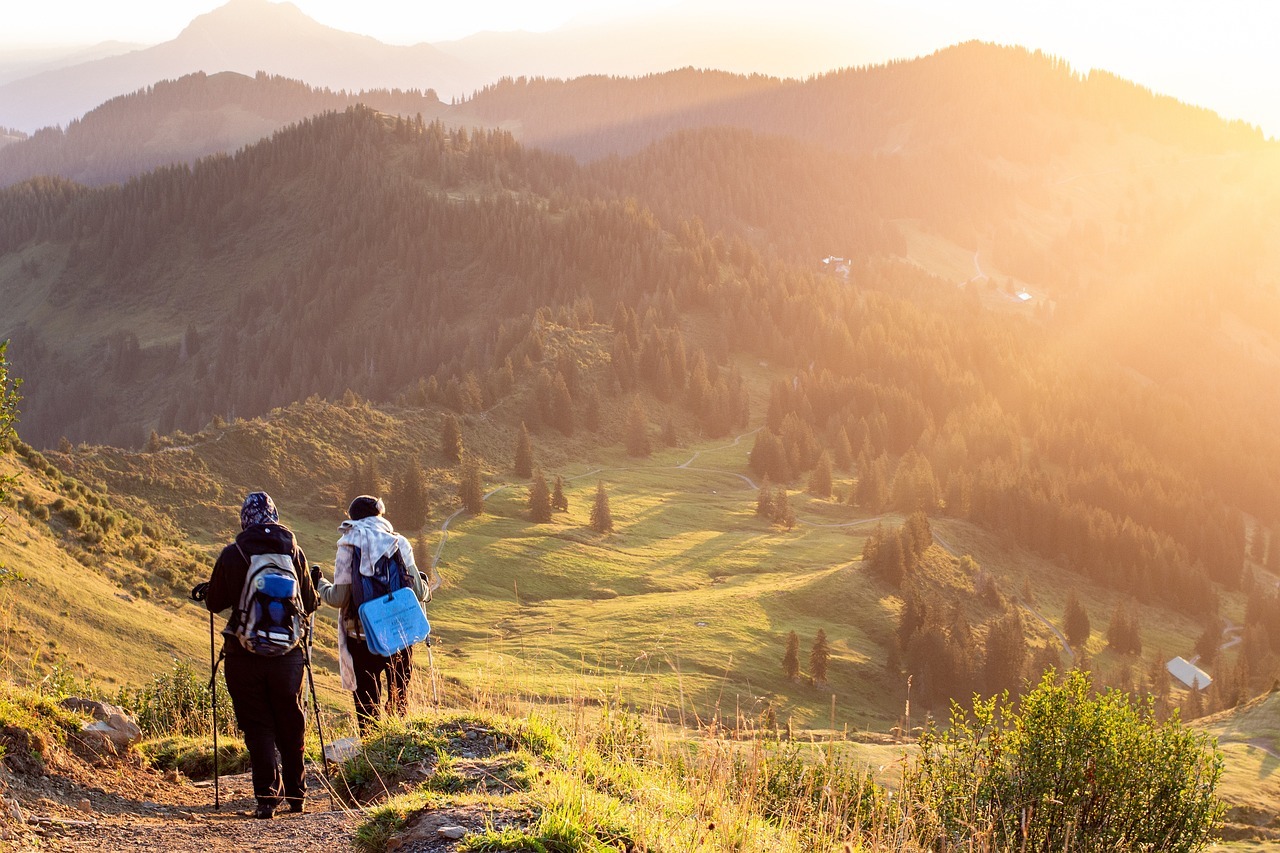Embarking on a hiking adventure is a thrilling experience, immersing yourself in the beauty of nature. Yet, the joy can quickly turn to discomfort or even danger without the right preparations. In this guide, we’ll delve into the top 20 hiking essentials that should find a place in your backpack. Whether you’re a seasoned hiker or a novice explorer, having the proper gear is non-negotiable. To maximize your enjoyment and safety on the trails, it’s imperative to compile a comprehensive list of hiking essentials. From sturdy footwear to navigation tools, we’ve got you covered with the must-haves for a seamless hiking experience. Let’s explore these crucial items that ensure you’re well-equipped for any terrain and ready to face the unexpected challenges Mother Nature might throw your way. So, lace up those boots and join us as we break down the ultimate hiker’s checklist for an adventure-packed journey.
1. Navigation
When it comes to navigation, having multiple tools is advantageous. While a map and compass are essential for traditional navigation, technology has introduced various GPS devices and smartphone apps that provide accurate positioning and route tracking. It’s crucial to choose a navigation tool that suits your preferences and the specific terrain you’ll be hiking in. Make sure to practice using your chosen tool before your hike to ensure you’re comfortable with its functions and features.
2. Sun Protection
Sun protection is often overlooked but is vital for any hiker. Sunscreen with a high SPF (Sun Protection Factor) should be applied generously to all exposed skin, including the face, neck, arms, and legs. Look for a broad-spectrum sunscreen that protects against both UVA and UVB rays. Sunglasses with UV protection help shield your eyes from harmful rays and reduce glare, enhancing visibility on sunny days. Additionally, a wide-brimmed hat provides shade for your face and neck, reducing the risk of sunburn and heat-related illnesses.
3. Insulation
Weather conditions can change rapidly during a hike, so it’s essential to be prepared for various scenarios. Even on a warm day, higher elevations or shady areas can be significantly cooler. Carrying a warm jacket or fleece allows you to layer up when needed, providing insulation and helping retain body heat. Opt for lightweight and packable options that won’t take up much space in your backpack. Similarly, a rain jacket or poncho serves as a crucial barrier against unexpected rain showers or sudden drops in temperature. Look for waterproof or water-resistant options that offer breathability to prevent sweating.
4. Illumination
Hiking is an adventure that can sometimes extend into the evening or require early morning starts. A reliable light source is indispensable in such situations. Headlamps are particularly convenient as they keep your hands free while providing ample illumination. Look for headlamps with adjustable brightness settings and long battery life. Carry spare batteries or ensure your headlamp is rechargeable before setting off. Additionally, it’s beneficial to pack a small flashlight as a backup or for tasks that require a focused beam of light.
5. First Aid
Accidents can happen on the trail, so a well-equipped first aid kit is a non-negotiable item. Pre-made first aid kits are readily available, but you can also customize one to suit your specific needs. Important items to include are adhesive bandages of various sizes, gauze pads, medical tape, antiseptic wipes, blister treatment, tweezers, scissors, pain relievers, and any personal medications you may require. Familiarize yourself with basic first aid techniques to effectively respond to common hiking injuries such as cuts, sprains, or blisters.
6. Firestarter
In emergency situations or when camping, having the means to start a fire is crucial. Matches and lighters are reliable firestarters, but it’s wise to carry waterproof or stormproof versions to ensure functionality even in adverse conditions. Another popular option is a firestarter kit, which usually includes flint or magnesium rods that can create sparks to ignite tinder. Regardless of the method you choose, practice building a fire responsibly and be mindful of any fire restrictions or regulations in the area you’re hiking.
7. Repair Kit and Tools
Being prepared for gear mishaps or unforeseen repairs is essential. Carrying a small repair kit can save the day when dealing with equipment malfunctions. Your repair kit may include items such as duct tape (which can fix almost anything!), extra buckles, straps, cordage, safety pins, a sewing kit, and a basic multi-tool. A multi-tool is a versatile gadget that combines several useful tools like pliers, knives, screwdrivers, and more. Having these items at hand can help you make temporary fixes and prevent minor gear issues from ruining your hike.
8. Nutrition
Hiking requires a significant amount of energy, so packing high-energy snacks is crucial to keep you fueled throughout the journey. Trail mix, energy bars, dried fruit, nuts, and jerky are popular options as they provide a mix of carbohydrates, protein, and healthy fats. Choose snacks that are lightweight, non-perishable, and easily accessible. Consider portioning them into individual servings to make them more convenient to consume while on the move. It’s also important to plan and pack enough food for the duration of your hike, especially if you’ll be in remote areas with limited access to resupply.
9. Hydration
Staying properly hydrated during a hike is essential for maintaining performance and preventing dehydration. Water is your best friend on the trail, so make sure you have an adequate supply. The amount of water needed depends on the duration and intensity of your hike, as well as environmental factors such as temperature and elevation. It’s recommended to carry at least two liters of water per person, but adjust this amount based on your individual needs and the availability of water sources along the trail. In areas with natural water sources, consider carrying a water filter or purification tablets to treat water before consumption, ensuring it’s safe from contaminants.
10. Emergency Shelter
While most hikes are completed within a day, unexpected situations can arise, such as getting lost, encountering severe weather, or experiencing an injury that prevents you from completing the hike as planned. In such cases, having a lightweight emergency shelter can provide much-needed protection and comfort. Bivy sacks and emergency blankets are popular options as they are compact, lightweight, and offer insulation to retain body heat. These emergency shelters can make a significant difference if you need to spend an unexpected night outdoors.
11. Personal Items
In addition to the essential hiking gear, there are a few personal items that you should consider carrying. A camera allows you to capture the breathtaking views and memorable moments along the trail. It’s also worth packing a phone for emergency communication, taking photos, and using helpful hiking apps. Remember to keep your phone fully charged before the hike and conserve battery life by switching to airplane mode or carrying a portable charger. If you require any medications, ensure you have an adequate supply and keep them easily accessible in a waterproof container. Additionally, carrying a small notebook and pen can be useful for jotting down observations, trail notes, or leaving messages for other hikers.
12. Clothing
Choosing the right clothing for your hike can significantly impact your comfort and safety. Layering is key to regulate body temperature and adapt to changing weather conditions. Start with a moisture-wicking base layer that draws sweat away from your skin, keeping you dry and preventing chills. Synthetic or wool materials are preferable over cotton, as cotton tends to retain moisture and can make you feel cold and uncomfortable. Depending on the weather, add a mid-layer such as a fleece or lightweight insulated jacket for extra warmth. Finally, top it off with a waterproof and breathable outer layer, such as a rain jacket, to protect against wind and rain. Don’t forget to pack extra socks, as they can make a significant difference in keeping your feet dry and blister-free.
13. Footwear
Choosing the right footwear is paramount to ensure a comfortable and safe hiking experience. Invest in a pair of sturdy and properly fitting hiking boots or shoes that provide good ankle support, traction, and protection. Consider the type of terrain you’ll be hiking on to determine whether you need lightweight hiking shoes, mid-cut boots, or heavy-duty mountaineering boots. Prioritize comfort and break in your footwear before embarking on a long hike to avoid blisters and discomfort.
14. Trekking Poles
Trekking poles are valuable tools that can enhance your hiking experience, particularly on challenging terrains. These poles provide stability and balance, reducing strain on your knees and leg muscles. They can also help navigate steep ascents and descents by providing extra points of contact with the ground. Look for lightweight and adjustable trekking poles with comfortable grips and reliable locking mechanisms. Consider collapsible poles for easy storage when not in use.
15 .Insect Repellent
When hiking in areas where insects are prevalent, insect repellent is essential for warding off bites and potential diseases. Mosquitoes, ticks, and other biting insects can be more than just an annoyance. Apply an effective insect repellent to exposed skin and clothing, following the product’s instructions. Consider choosing a repellent that specifically targets ticks if you’ll be hiking in tick-prone areas. Wearing long sleeves, long pants, and socks treated with insect repellent or permethrin can provide an additional layer of protection.
16. Emergency Communication
Ensuring reliable communication during emergencies is crucial when venturing into remote areas. Carrying a fully charged mobile phone is recommended, as it allows you to call for help if needed. However, keep in mind that cell phone coverage may be limited in some wilderness areas. In such cases, consider investing in a satellite communicator like SPOT or Garmin inReach. These devices use satellite networks to send distress signals and allow you to communicate via text messages, even in areas without cellular service. Familiarize yourself with the operation of your chosen device and register it as needed before setting out on your hike.
17. Map and Trail Guide
While digital navigation tools are convenient, carrying a physical map and trail guide is crucial. Maps provide an overview of the area, topographic details, and essential landmarks. Trail guides offer valuable information about the trail’s length, difficulty, notable points of interest, and potential hazards. Even if you rely on electronic navigation, having a physical backup can be a lifesaver if your device malfunctions or runs out of battery. Additionally, studying the map and guide beforehand allows you to familiarize yourself with the trail and plan your route accordingly.
18. Group Gear
If you’re hiking with a group, sharing certain gear items can help distribute the weight and optimize space in everyone’s backpacks. Group gear may include items like a larger shelter or tent, a cooking stove, cookware, and a water filter. Discuss and plan with your hiking companions to determine who will carry which items to ensure a fair distribution. This approach reduces individual load and fosters camaraderie within the group.
19. Permits and Fees
Before embarking on your hike, research and determine if any permits or fees are required for the area you’ll be visiting. Some popular hiking destinations or protected areas may require permits to limit the number of visitors or protect sensitive ecosystems. Additionally, certain parks or trailheads may charge parking or access fees. Check the relevant websites or contact local authorities to understand the requirements and make necessary arrangements ahead of time. Respecting these regulations helps preserve the natural environment and ensures a smooth hiking experience.
20. Leave No Trace Principles
One of the essential aspects of responsible hiking is adhering to the Leave No Trace principles. These principles provide guidelines for minimizing our impact on the environment and leaving it pristine for future generations to enjoy. The principles include practices such as packing out all trash, disposing of waste properly, staying on designated trails to avoid damaging vegetation, minimizing campfire impact, respecting wildlife, and being considerate of other hikers. Familiarize yourself with the Leave No Trace principles and strive to incorporate them into your hiking practices. By doing so, you contribute to the preservation of our natural spaces and promote sustainable outdoor recreation.
In conclusion, crafting an extensive hiker’s checklist is the key to unlocking the full potential of your hiking adventures. This meticulously curated list ensures that you’re armed with the essential gear, equipment, and knowledge needed to elevate your outdoor experiences. Each item on the checklist serves a pivotal role in guaranteeing your comfort, safety, and overall enjoyment while navigating the trails. It’s essential to recognize that customization is key; tailor the checklist to the unique requirements of your hike, considering variables like duration, terrain, weather conditions, and group size.
By conscientiously preparing and outfitting yourself with the right tools, you pave the way for unforgettable hiking escapades, allowing you to fully immerse yourself in the breathtaking beauty of the great outdoors. Remember, the journey is not just about reaching the destination; it’s about relishing every step, savoring the sights, and conquering challenges with confidence. So, as you prepare for your next hiking expedition, let this checklist be your trusted guide, ensuring that every moment on the trail becomes a cherished memory. Gear up, venture forth, and embrace the wilderness with open arms!





